Civil Engineering: Noise Reduction in Building Design Solutions
VerifiedAdded on 2021/06/17
|6
|1123
|62
Homework Assignment
AI Summary
This assignment provides a detailed analysis of construction design solutions aimed at reducing noise pollution. It begins by examining methods to reduce noise at its source, including the use of enclosures and heavy construction, and highlights the importance of strategic placement of noisy machinery. The document then explores flanking sound transmission, explaining how sound travels through building structures and how to mitigate this through air-tight construction and absorbent panels. It further discusses the challenges of structure-borne sound transmission, particularly in older apartment blocks. The assignment also covers discontinuous construction techniques, illustrating how separated walls can reduce sound transmission. Finally, it delves into auditorium design principles, emphasizing the importance of shape, volume, and surface distribution in achieving optimal acoustics for live theater performances. The assignment includes references to relevant literature supporting the discussed concepts.
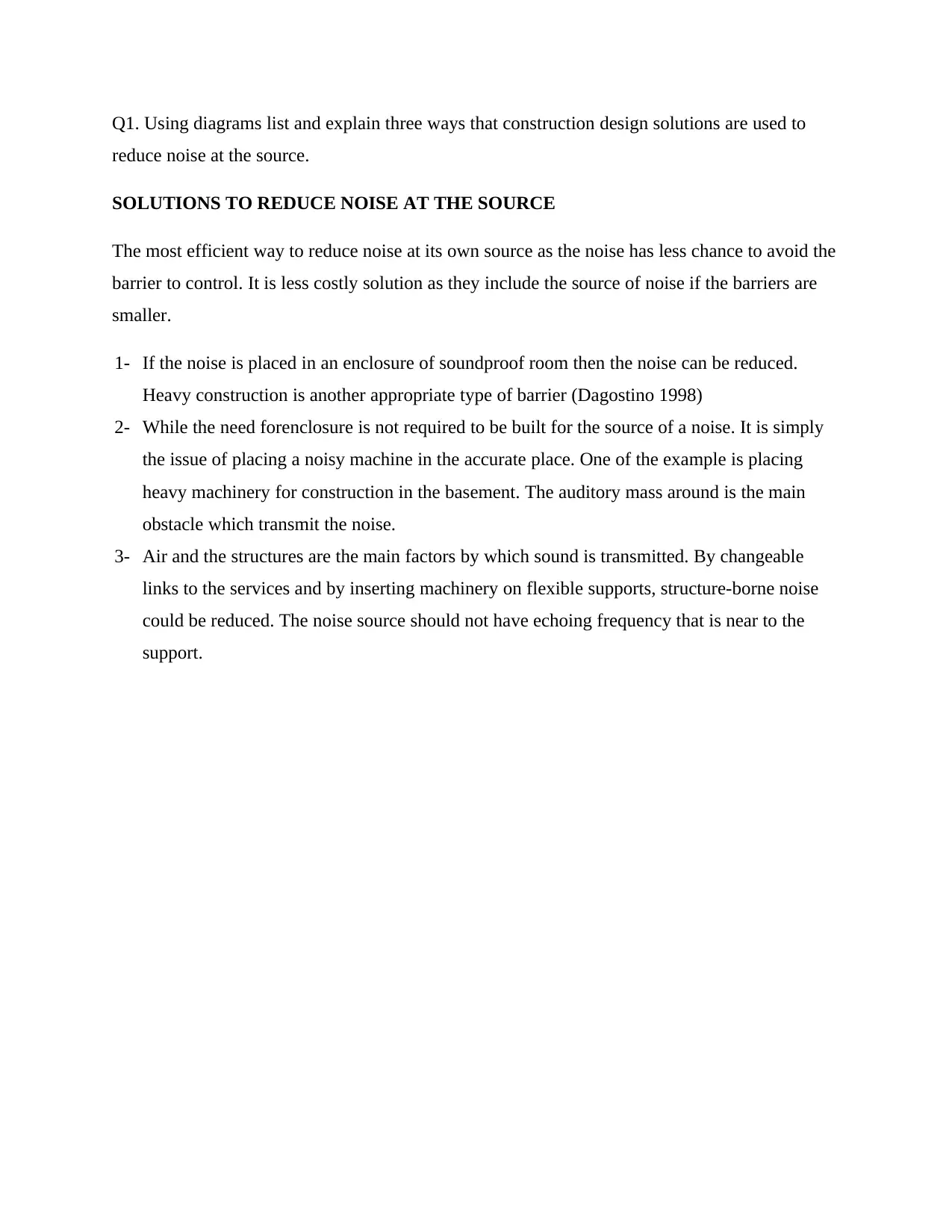
Q1. Using diagrams list and explain three ways that construction design solutions are used to
reduce noise at the source.
SOLUTIONS TO REDUCE NOISE AT THE SOURCE
The most efficient way to reduce noise at its own source as the noise has less chance to avoid the
barrier to control. It is less costly solution as they include the source of noise if the barriers are
smaller.
1- If the noise is placed in an enclosure of soundproof room then the noise can be reduced.
Heavy construction is another appropriate type of barrier (Dagostino 1998)
2- While the need forenclosure is not required to be built for the source of a noise. It is simply
the issue of placing a noisy machine in the accurate place. One of the example is placing
heavy machinery for construction in the basement. The auditory mass around is the main
obstacle which transmit the noise.
3- Air and the structures are the main factors by which sound is transmitted. By changeable
links to the services and by inserting machinery on flexible supports, structure-borne noise
could be reduced. The noise source should not have echoing frequency that is near to the
support.
reduce noise at the source.
SOLUTIONS TO REDUCE NOISE AT THE SOURCE
The most efficient way to reduce noise at its own source as the noise has less chance to avoid the
barrier to control. It is less costly solution as they include the source of noise if the barriers are
smaller.
1- If the noise is placed in an enclosure of soundproof room then the noise can be reduced.
Heavy construction is another appropriate type of barrier (Dagostino 1998)
2- While the need forenclosure is not required to be built for the source of a noise. It is simply
the issue of placing a noisy machine in the accurate place. One of the example is placing
heavy machinery for construction in the basement. The auditory mass around is the main
obstacle which transmit the noise.
3- Air and the structures are the main factors by which sound is transmitted. By changeable
links to the services and by inserting machinery on flexible supports, structure-borne noise
could be reduced. The noise source should not have echoing frequency that is near to the
support.
Paraphrase This Document
Need a fresh take? Get an instant paraphrase of this document with our AI Paraphraser
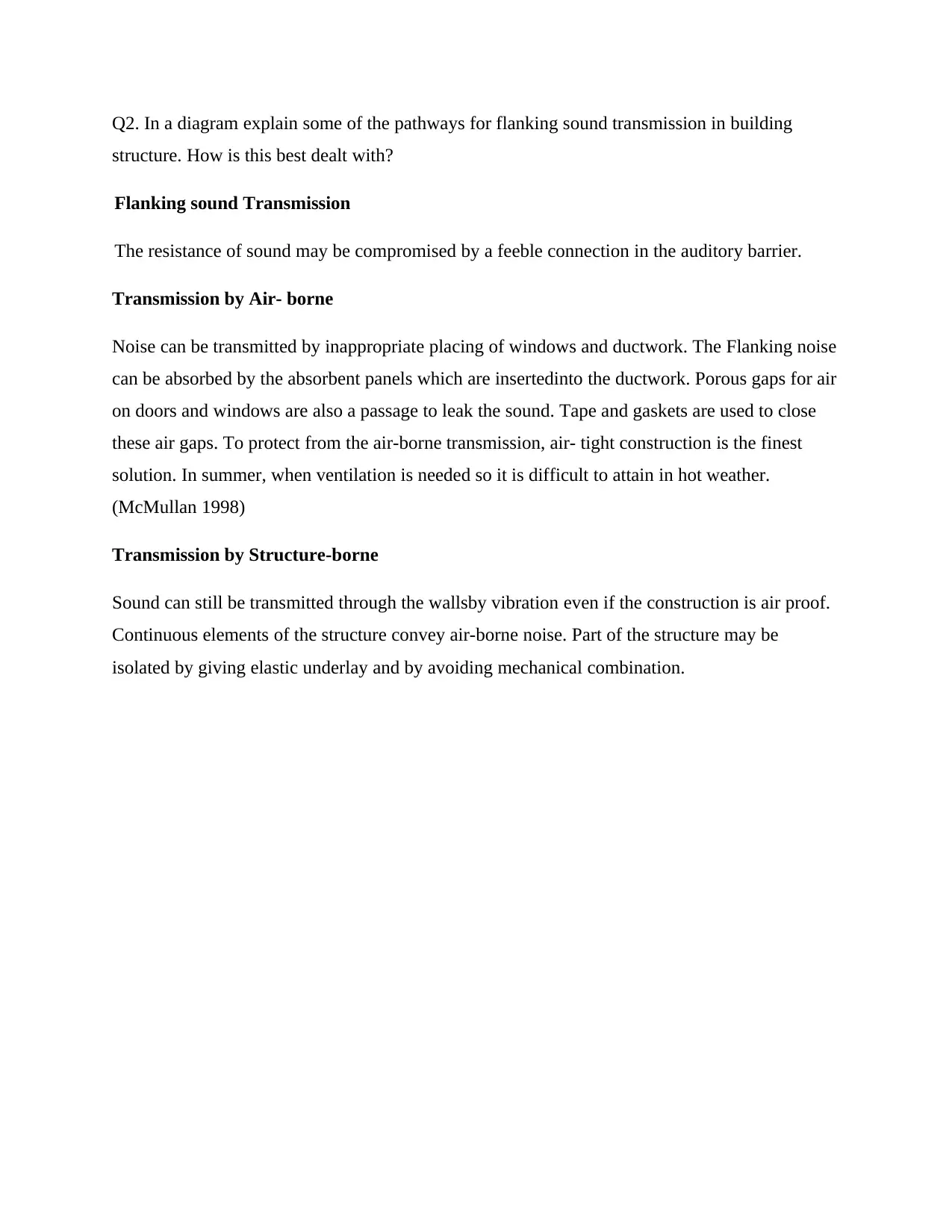
Q2. In a diagram explain some of the pathways for flanking sound transmission in building
structure. How is this best dealt with?
Flanking sound Transmission
The resistance of sound may be compromised by a feeble connection in the auditory barrier.
Transmission by Air- borne
Noise can be transmitted by inappropriate placing of windows and ductwork. The Flanking noise
can be absorbed by the absorbent panels which are insertedinto the ductwork. Porous gaps for air
on doors and windows are also a passage to leak the sound. Tape and gaskets are used to close
these air gaps. To protect from the air-borne transmission, air- tight construction is the finest
solution. In summer, when ventilation is needed so it is difficult to attain in hot weather.
(McMullan 1998)
Transmission by Structure-borne
Sound can still be transmitted through the wallsby vibration even if the construction is air proof.
Continuous elements of the structure convey air-borne noise. Part of the structure may be
isolated by giving elastic underlay and by avoiding mechanical combination.
structure. How is this best dealt with?
Flanking sound Transmission
The resistance of sound may be compromised by a feeble connection in the auditory barrier.
Transmission by Air- borne
Noise can be transmitted by inappropriate placing of windows and ductwork. The Flanking noise
can be absorbed by the absorbent panels which are insertedinto the ductwork. Porous gaps for air
on doors and windows are also a passage to leak the sound. Tape and gaskets are used to close
these air gaps. To protect from the air-borne transmission, air- tight construction is the finest
solution. In summer, when ventilation is needed so it is difficult to attain in hot weather.
(McMullan 1998)
Transmission by Structure-borne
Sound can still be transmitted through the wallsby vibration even if the construction is air proof.
Continuous elements of the structure convey air-borne noise. Part of the structure may be
isolated by giving elastic underlay and by avoiding mechanical combination.
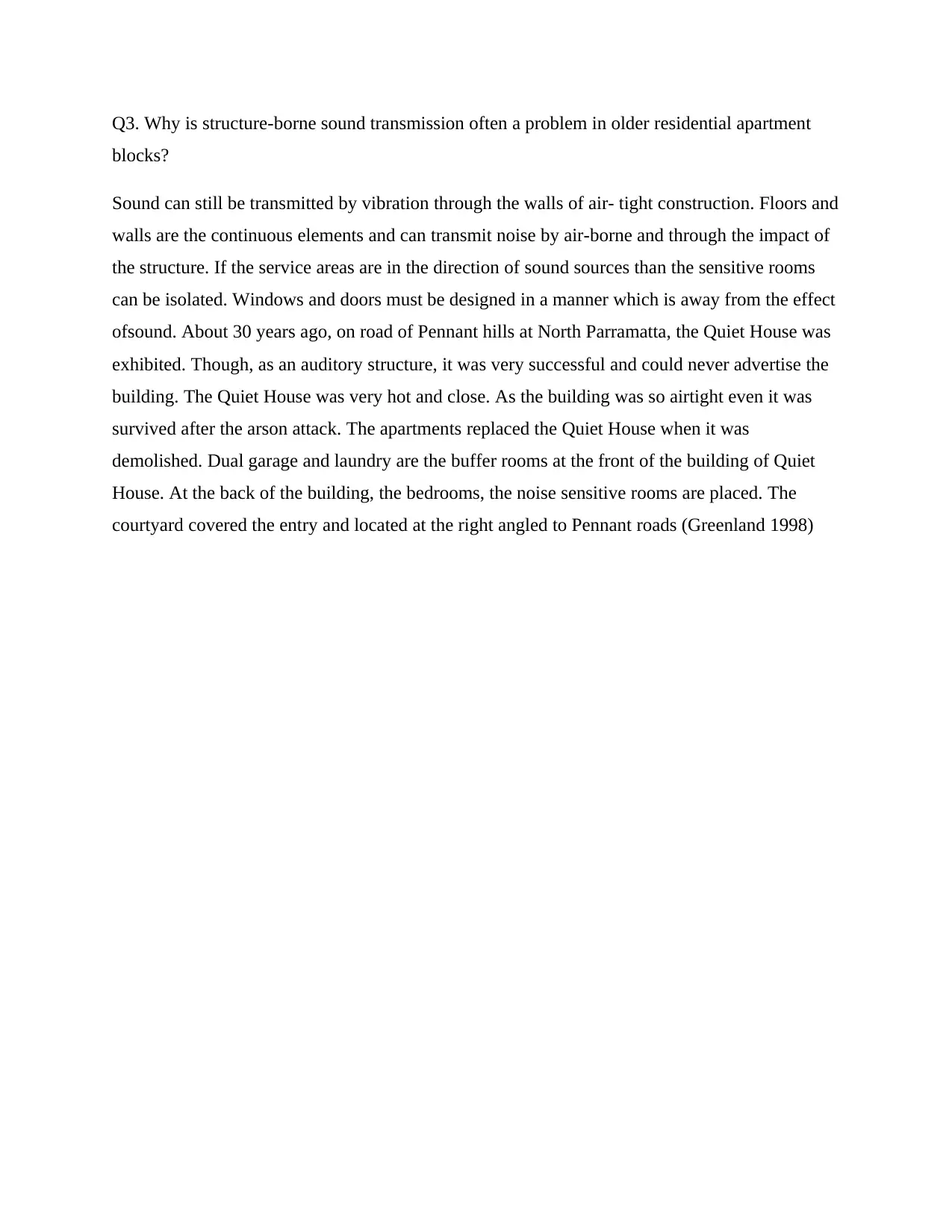
Q3. Why is structure-borne sound transmission often a problem in older residential apartment
blocks?
Sound can still be transmitted by vibration through the walls of air- tight construction. Floors and
walls are the continuous elements and can transmit noise by air-borne and through the impact of
the structure. If the service areas are in the direction of sound sources than the sensitive rooms
can be isolated. Windows and doors must be designed in a manner which is away from the effect
ofsound. About 30 years ago, on road of Pennant hills at North Parramatta, the Quiet House was
exhibited. Though, as an auditory structure, it was very successful and could never advertise the
building. The Quiet House was very hot and close. As the building was so airtight even it was
survived after the arson attack. The apartments replaced the Quiet House when it was
demolished. Dual garage and laundry are the buffer rooms at the front of the building of Quiet
House. At the back of the building, the bedrooms, the noise sensitive rooms are placed. The
courtyard covered the entry and located at the right angled to Pennant roads (Greenland 1998)
blocks?
Sound can still be transmitted by vibration through the walls of air- tight construction. Floors and
walls are the continuous elements and can transmit noise by air-borne and through the impact of
the structure. If the service areas are in the direction of sound sources than the sensitive rooms
can be isolated. Windows and doors must be designed in a manner which is away from the effect
ofsound. About 30 years ago, on road of Pennant hills at North Parramatta, the Quiet House was
exhibited. Though, as an auditory structure, it was very successful and could never advertise the
building. The Quiet House was very hot and close. As the building was so airtight even it was
survived after the arson attack. The apartments replaced the Quiet House when it was
demolished. Dual garage and laundry are the buffer rooms at the front of the building of Quiet
House. At the back of the building, the bedrooms, the noise sensitive rooms are placed. The
courtyard covered the entry and located at the right angled to Pennant roads (Greenland 1998)
⊘ This is a preview!⊘
Do you want full access?
Subscribe today to unlock all pages.

Trusted by 1+ million students worldwide
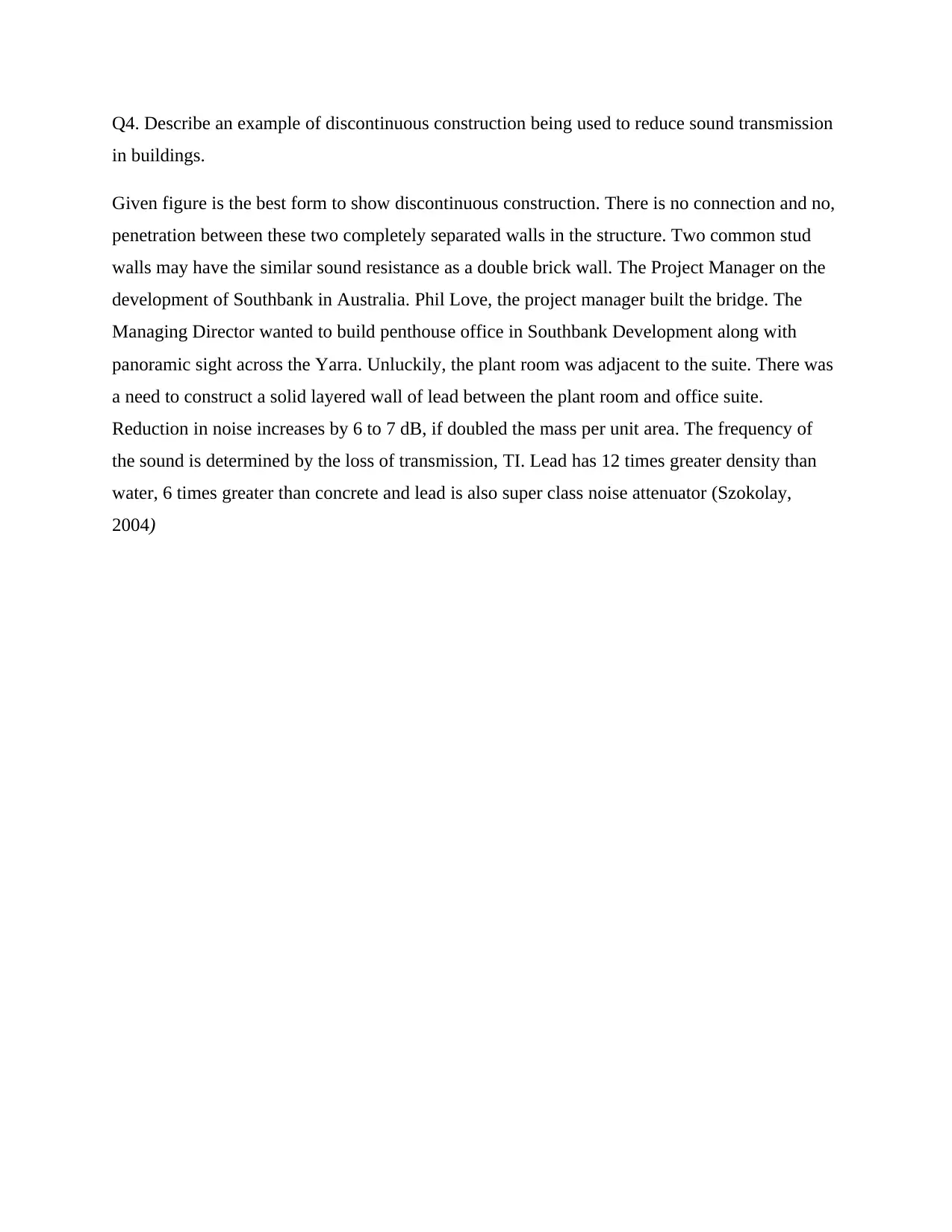
Q4. Describe an example of discontinuous construction being used to reduce sound transmission
in buildings.
Given figure is the best form to show discontinuous construction. There is no connection and no,
penetration between these two completely separated walls in the structure. Two common stud
walls may have the similar sound resistance as a double brick wall. The Project Manager on the
development of Southbank in Australia. Phil Love, the project manager built the bridge. The
Managing Director wanted to build penthouse office in Southbank Development along with
panoramic sight across the Yarra. Unluckily, the plant room was adjacent to the suite. There was
a need to construct a solid layered wall of lead between the plant room and office suite.
Reduction in noise increases by 6 to 7 dB, if doubled the mass per unit area. The frequency of
the sound is determined by the loss of transmission, TI. Lead has 12 times greater density than
water, 6 times greater than concrete and lead is also super class noise attenuator (Szokolay,
2004)
in buildings.
Given figure is the best form to show discontinuous construction. There is no connection and no,
penetration between these two completely separated walls in the structure. Two common stud
walls may have the similar sound resistance as a double brick wall. The Project Manager on the
development of Southbank in Australia. Phil Love, the project manager built the bridge. The
Managing Director wanted to build penthouse office in Southbank Development along with
panoramic sight across the Yarra. Unluckily, the plant room was adjacent to the suite. There was
a need to construct a solid layered wall of lead between the plant room and office suite.
Reduction in noise increases by 6 to 7 dB, if doubled the mass per unit area. The frequency of
the sound is determined by the loss of transmission, TI. Lead has 12 times greater density than
water, 6 times greater than concrete and lead is also super class noise attenuator (Szokolay,
2004)
Paraphrase This Document
Need a fresh take? Get an instant paraphrase of this document with our AI Paraphraser
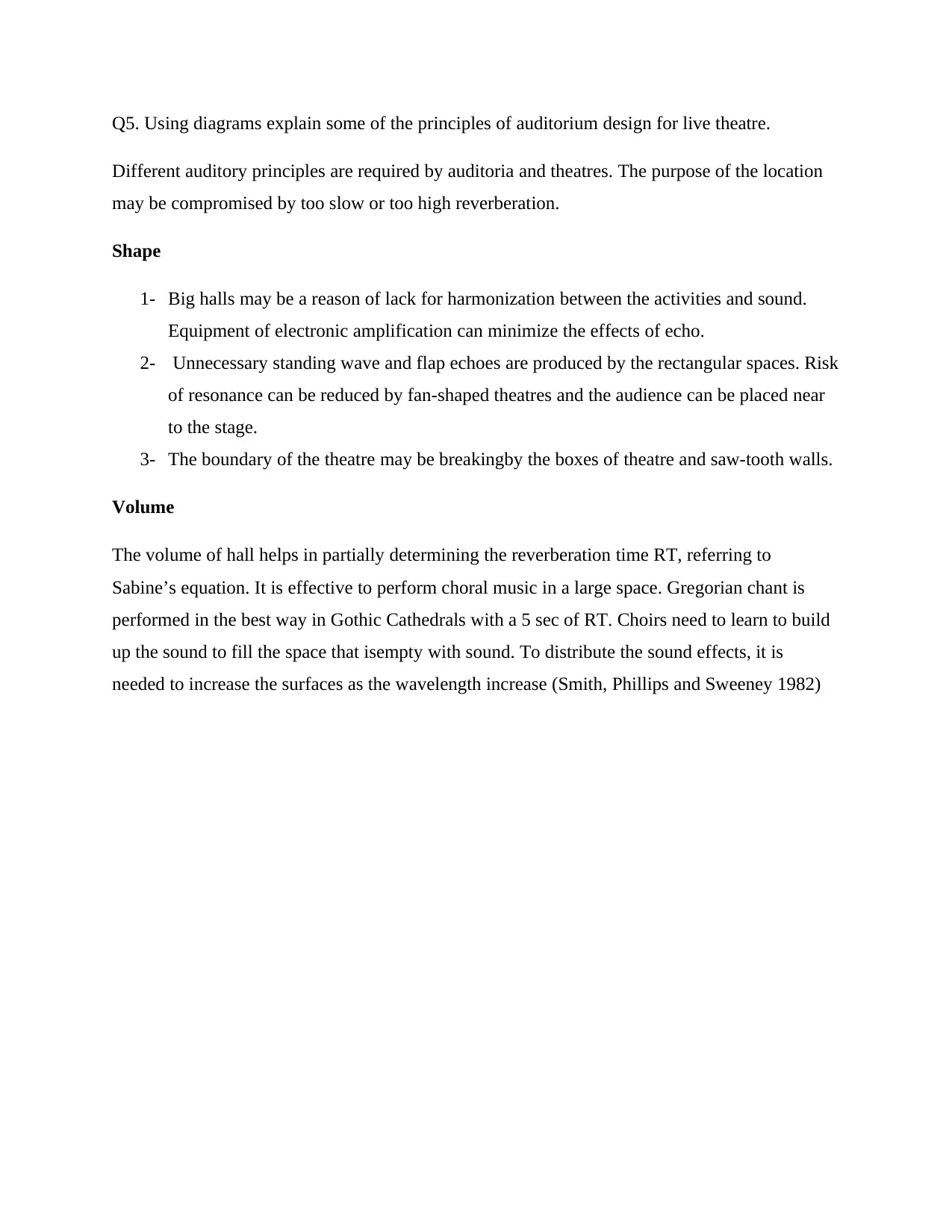
Q5. Using diagrams explain some of the principles of auditorium design for live theatre.
Different auditory principles are required by auditoria and theatres. The purpose of the location
may be compromised by too slow or too high reverberation.
Shape
1- Big halls may be a reason of lack for harmonization between the activities and sound.
Equipment of electronic amplification can minimize the effects of echo.
2- Unnecessary standing wave and flap echoes are produced by the rectangular spaces. Risk
of resonance can be reduced by fan-shaped theatres and the audience can be placed near
to the stage.
3- The boundary of the theatre may be breakingby the boxes of theatre and saw-tooth walls.
Volume
The volume of hall helps in partially determining the reverberation time RT, referring to
Sabine’s equation. It is effective to perform choral music in a large space. Gregorian chant is
performed in the best way in Gothic Cathedrals with a 5 sec of RT. Choirs need to learn to build
up the sound to fill the space that isempty with sound. To distribute the sound effects, it is
needed to increase the surfaces as the wavelength increase (Smith, Phillips and Sweeney 1982)
Different auditory principles are required by auditoria and theatres. The purpose of the location
may be compromised by too slow or too high reverberation.
Shape
1- Big halls may be a reason of lack for harmonization between the activities and sound.
Equipment of electronic amplification can minimize the effects of echo.
2- Unnecessary standing wave and flap echoes are produced by the rectangular spaces. Risk
of resonance can be reduced by fan-shaped theatres and the audience can be placed near
to the stage.
3- The boundary of the theatre may be breakingby the boxes of theatre and saw-tooth walls.
Volume
The volume of hall helps in partially determining the reverberation time RT, referring to
Sabine’s equation. It is effective to perform choral music in a large space. Gregorian chant is
performed in the best way in Gothic Cathedrals with a 5 sec of RT. Choirs need to learn to build
up the sound to fill the space that isempty with sound. To distribute the sound effects, it is
needed to increase the surfaces as the wavelength increase (Smith, Phillips and Sweeney 1982)
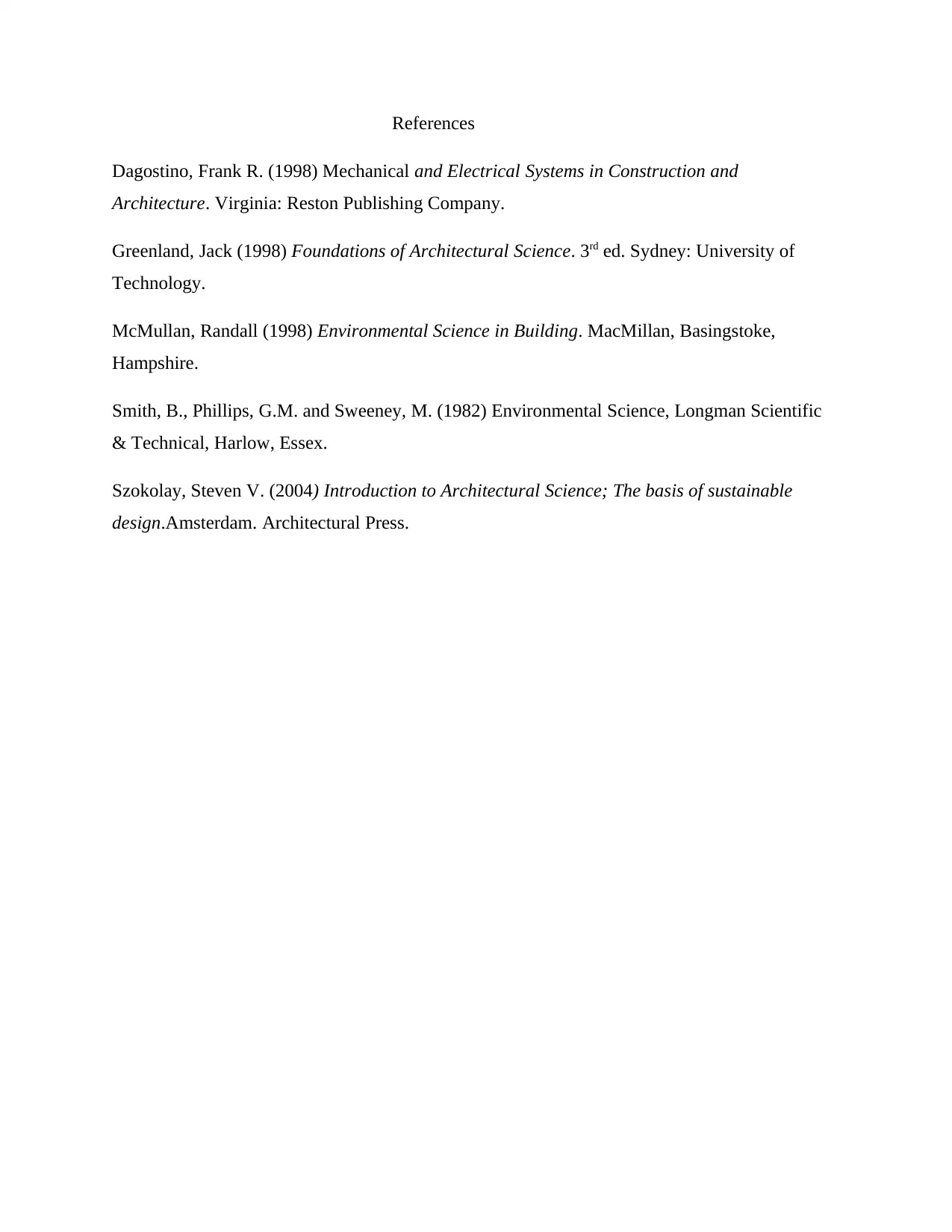
References
Dagostino, Frank R. (1998) Mechanical and Electrical Systems in Construction and
Architecture. Virginia: Reston Publishing Company.
Greenland, Jack (1998) Foundations of Architectural Science. 3rd ed. Sydney: University of
Technology.
McMullan, Randall (1998) Environmental Science in Building. MacMillan, Basingstoke,
Hampshire.
Smith, B., Phillips, G.M. and Sweeney, M. (1982) Environmental Science, Longman Scientific
& Technical, Harlow, Essex.
Szokolay, Steven V. (2004) Introduction to Architectural Science; The basis of sustainable
design.Amsterdam. Architectural Press.
Dagostino, Frank R. (1998) Mechanical and Electrical Systems in Construction and
Architecture. Virginia: Reston Publishing Company.
Greenland, Jack (1998) Foundations of Architectural Science. 3rd ed. Sydney: University of
Technology.
McMullan, Randall (1998) Environmental Science in Building. MacMillan, Basingstoke,
Hampshire.
Smith, B., Phillips, G.M. and Sweeney, M. (1982) Environmental Science, Longman Scientific
& Technical, Harlow, Essex.
Szokolay, Steven V. (2004) Introduction to Architectural Science; The basis of sustainable
design.Amsterdam. Architectural Press.
⊘ This is a preview!⊘
Do you want full access?
Subscribe today to unlock all pages.

Trusted by 1+ million students worldwide
1 out of 6
Related Documents
Your All-in-One AI-Powered Toolkit for Academic Success.
+13062052269
info@desklib.com
Available 24*7 on WhatsApp / Email
![[object Object]](/_next/static/media/star-bottom.7253800d.svg)
Unlock your academic potential
Copyright © 2020–2025 A2Z Services. All Rights Reserved. Developed and managed by ZUCOL.




